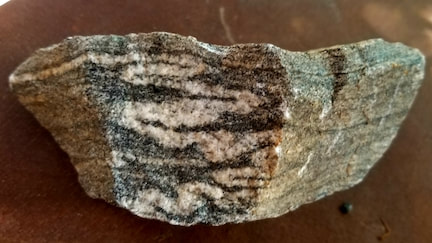Another characteristic feature of metamorphic rocks is a texture called foliation, from the Latin "folium", for leaf.
To bring layers of sediment or volcanic rocks, which form at or near the Earth's surface, down into the plutonic realm, the rocks will not only be subjected to greater and greater confining pressure, but almost certainly to unbalanced forces - pushes, pulls, or twists - that will change the shape of the rocks.
These forces will cause shearing within the body of the rocks. Shearing is a sliding of one part of a material past another
To bring layers of sediment or volcanic rocks, which form at or near the Earth's surface, down into the plutonic realm, the rocks will not only be subjected to greater and greater confining pressure, but almost certainly to unbalanced forces - pushes, pulls, or twists - that will change the shape of the rocks.
These forces will cause shearing within the body of the rocks. Shearing is a sliding of one part of a material past another
This will have a strong effect on recrystallizing minerals. Mineral crystals that are platy, like mica, which recrystallizes from clay, will become strongly flattened and interleaved with one another. Mineral crystals that are needle-shaped or prismatic, like hornblende, will be forced to grow in the same plane, and will very likely be aligned with one another.
This foliation effect is particularly well displayed by the progressive metamorphism of shale, rich in clay minerals and quartz silt, and the most common of the sedimentary rocks.
At first, tiny segregations of aligned minerals from more granular ones will develop. The effect will be to develop a distinct leaf-like grain to the rocks, along which they will tend to split. The way in which old-fashioned stone roofing slates are split out of the quarry is a perfect example.
At higher degrees of metamorphism, shiny mica begins to recrystallize from the clay, and the rocks develop a silvery sheen. Eventually enough aligned mica crystallizes that the rock is almost completely composed of it, mixed, perhaps, with a few aluminum-rich minerals like garnet that form only under high confining pressures. These rocks are called schist. As their name implies, schists split easily.
This foliation effect is particularly well displayed by the progressive metamorphism of shale, rich in clay minerals and quartz silt, and the most common of the sedimentary rocks.
At first, tiny segregations of aligned minerals from more granular ones will develop. The effect will be to develop a distinct leaf-like grain to the rocks, along which they will tend to split. The way in which old-fashioned stone roofing slates are split out of the quarry is a perfect example.
At higher degrees of metamorphism, shiny mica begins to recrystallize from the clay, and the rocks develop a silvery sheen. Eventually enough aligned mica crystallizes that the rock is almost completely composed of it, mixed, perhaps, with a few aluminum-rich minerals like garnet that form only under high confining pressures. These rocks are called schist. As their name implies, schists split easily.
At the highest degrees of metamorphism, the segregation of platy minerals like mica, and granular minerals like quartz and feldspar, creates a distinctly banded, granite-like rock called gneiss. At this point, the segregated layers are likely to be contorted into folds, and the rock, while foliated, resists splitting. Granite and gneiss are often found together, and together they form the projecting high peaks and ridges of many mountain ranges.



 RSS Feed
RSS Feed
